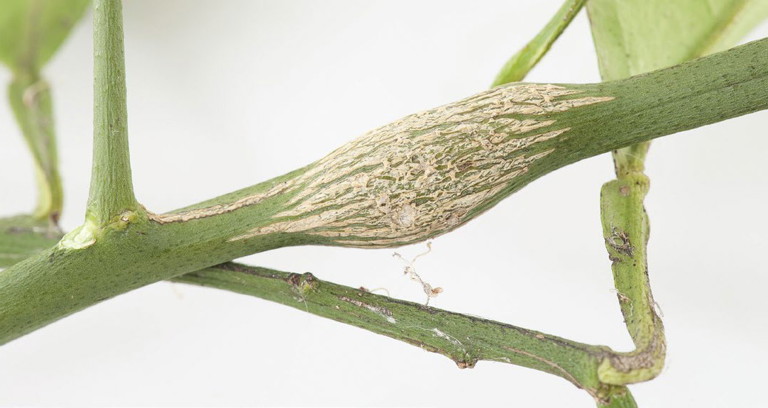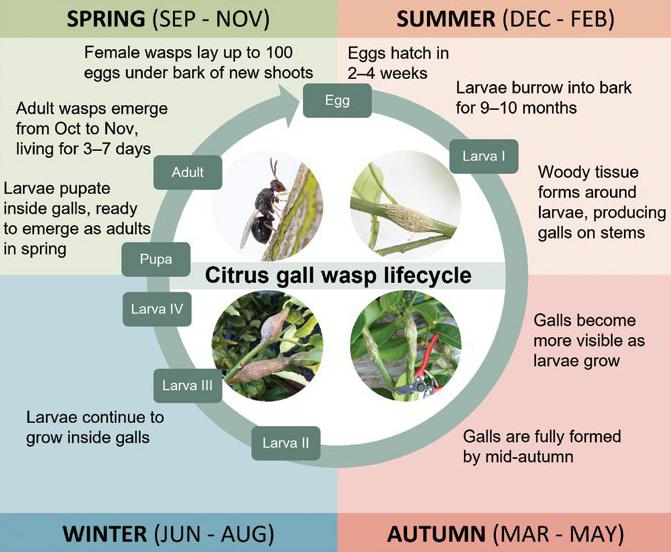WA CITRUS pest management

Citrus gall wasp damage.
Wasp
WATCH
Citrus gall wasp is in our suburbs, so stay vigilant to ensure it stays away from our fruit.
Words Rachelle Johnstone, WA Citrus industry development officer Photography Pia Scanlan, DPIRD
WE want to put out a timely reminder for growers to keep an eye out for signs of citrus gall wasp (Bruchophagus fellis) after the pest was recently found in a citrus tree in Bindoon.
Citrus gall wasp (CGW) is an Australian native insect from northern NSW and Queensland. It has spread throughout the major citrus production regions of eastern Australia and is considered a serious pest. It has not yet been found in citrus orchards in WA but is well established in Perth metro areas.
Wasp Lifecycle
CGW produces a single generation each year, spending 95% of its growth and development inside galls in branches. Adults are small, shiny black wasps (2.5mm), that live for three to seven days, depending on temperature. Egg laying starts after wasps emerge in spring, with most laid in the first three days. Females can lay up to 100 eggs under the bark of spring flush. CGW adults do not fly far from where they emerge, but can spread far by wind or movement of infested plant material. Eggs hatch in two to four weeks, then larvae burrow into bark for nine to 10 months. Woody tissue forms around the larvae causing the distinctive swelling. By winter, the larvae inside the gall pupate ready to emerge as adults in spring.
How to Monitor
Monitoring is essential for CGW control, as low-level infestation may not require chemical intervention. New infestations are difficult to detect as galls can be small and hidden in the canopy behind summer and autumn flushes. In southern WA, winter is the best time to check for galls; they are fully formed and easily visible. Galls are more abundant in the lower canopy, so check underneath the canopy and look for shoots growing at right angles from the main branch. With a new infestation, galls will be small (less than 10mm long) and scattered. Check rootstock suckers: these are highly attractive to CGW. The wasp itself is small and difficult to see when it emerges in spring.
Required Control
An integrated pest management (IPM) approach to CGW based on monitoring, and cultural, biological and chemical control will be most effective. Regular monitoring is key for early detection and identifying levels of infestation. Consider involving neighbours in an area-wide management approach.
Cultural Considerations
Management strategies currently focus on removing galls before emergence. In orchards where CGW is first found, the best option is to remove the galls. If removed before July, galls can be left in the orchard without further treatment. Galls should be mulched if removed less than eight weeks before the emergence period as wasps may still survive.
Biological Help
Megastigmus brevivalvus and M. trisulcus are two beneficial wasps present in WA. They lay their eggs directly into citrus gall wasp eggs, eventually killing the larvae. Unfortunately, they are not present in sufficient numbers to control citrus gall wasp.

The CGW lifecycle in southern Australia.
“ [CGW] has not yet been found in citrus orchards in WA, but has become well established in the Perth metropolitan area over the past 10 years ”
Chemical Intervention
Calcined kaolin can be used as a film to protect new growth during spring when wasps emerge. It acts as a repellent and can disrupt egg laying if spring flush is adequately covered. Two or more applications may be required. If using Aphytis parasitic wasps as part of an IPDM approach to control red scale, be aware this product may decrease their activity, so monitor scale.
If CGW becomes well established, chemical intervention may be required to reduce the population.
Systemic soil-applied insecticides containing imidacloprid or clothianidin are registered for the control and suppression of CGW. They are applied after flowering to target larvae before they form galls. Always refer to labels before use as these products have long withholding periods and tree size can impact their efficacy. Continuous use of soil-applied systemic insecticides is not recommended as it can lead to insecticide resistance, disrupt beneficial insects and cause secondary pest problems.
You’ve found CGW. What now?
Early detection is important for effective control of this pest. Damage caused by CGW can lead to reduced fruit size and yield in heavily infested trees. If you find galls, report them on the MyPestGuide reporter app or the web tool at mypestguide.agric.wa.gov.au
FOR MORE INFORMATION
Contact Rachelle Johnstone at rachelle.johnstone@dpird.wa.gov.au; see more on CGW control at agric.wa.gov.au/citrus-gall-wasp; and find a CGW IPDM Fact Sheet at www.dpi.nsw.gov.au/__data/assets/pdf_file/0010/1457848/Citrus-gall-wasp.pdf.